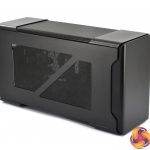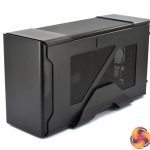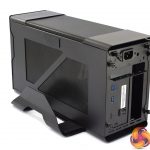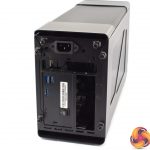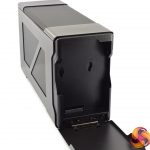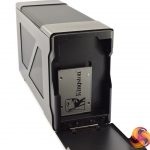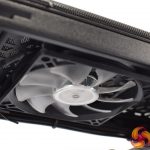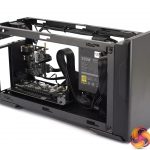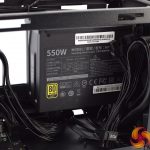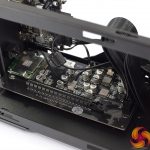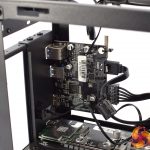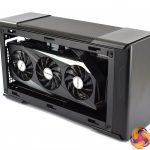Before closing out, it's worth taking a closer look at the Cooler Master EG200:
Cooler Master EG200 Specification:
- SERIES: MasterCase Series
- SIZE: External GPU
- MODEL NUMBER: MCM-EG200-KNNA55-S00, MCM-EG200-KNNA55-UK
- AVAILABLE COLOR(S): Black
- MATERIALS: Steel, Plastic, Mesh
- DIMENSIONS (L X W X H): 383 x 140 x 208mm (incl. Protrusions), 371 x 128 x 204mm (excl. Protrusions)
- VOLUME (EXLC. PROTRUSIONS): 9.7L
- EXPANSION SLOTS: N/A
- I/O PANEL – USB PORTS: 3x USB 3.2 Gen 1 Type-A
- I/O PANEL – USB IN: 1x USB Micro-B 3.2 Gen 1
- I/O PANEL – TB3: USB C
- HARD DRIVE DOCK: 2.5” or 3.5” SATA drives
- PRE-INSTALLED FANS – TOP: 1x 92mm Slim PWM 2600RPM
- FAN SUPPORT – TOP: 1x 92mm
- CLEARANCE – GFX: L: 325 / 12.79inch, W: 54mm (2.5 slot) / 2.13inch, D: 141mm / 5.55inch, (Max. sizes incl. connector)
- CABLES: Thunderbolt 3 – 500mm, USB – 700mm (incl. USB A to C adapter)
- INCLUDED POWER SUPPLY: Cooler Master V Gold SFX (550W)
- INCLUDED POWER CABLES: 1x 24 pin, 2x 6+2 pin PCI-e, 1x SATA power
- USB POWER DELIVERY: 60W
This is Cooler Master's first external GPU enclosure and it has a number of features which could appeal. For one, it offers three USB Type-A ports, so you could connect a headset, keyboard and mouse directly to the enclosure. These ports are also provided by a separate internal daughterboard, so bandwidth isn't shared with the graphics card over Thunderbolt 3. This means a second cable is required between the chassis and your host machine, taking up one of your existing USB ports, but it still gives three back.
Additionally, the front panel of the EG200 lowers to reveal a drive caddy capable of housing a 2.5in or 3.5in drive. This is certainly something I've not seen before and would be perfect for laptop owners whose internal storage drives may only be 256GB in size.
Cooler Master has also built a laptop stand into the case. It's visible in the third picture of the top row from the gallery above, and it's adjustable to suit laptops of varying thicknesses. It's not a killer add-on in my opinion, but it does help to reduce the overall footprint of your setup when not in use.
There are, however, a few downsides that I noticed during my testing, and these mainly come down to ease of use. Primarily, getting inside the system is a bit of a faff. First of all, you have to unlock the laptop stand as, out of the box, it is pressed right against the right side panel. Then you can remove both side panels, which are secured with two thumbscrews each, and then it’s another 2 thumbscrews for the top panel. If you’re fitting a larger GPU, you may even have to remove one of the top support bars, which is another four screws. Compared to the Razer Core X, which uses a slider and rails system with zero screws, it is a somewhat convoluted process.
Once you are inside the chassis, there's a fair bit of cabling going on which can be a bit of a battle. The mainboard uses a thick 24-pin cable for power which occupies a fair amount of space and cannot be moved, while there's also a few trailing cables from the drive caddy at the front of the encoslure. You can of course still seat a graphics card in the x16 slot, but the process would be easier if there was less cable clutter.
 KitGuru KitGuru.net – Tech News | Hardware News | Hardware Reviews | IOS | Mobile | Gaming | Graphics Cards
KitGuru KitGuru.net – Tech News | Hardware News | Hardware Reviews | IOS | Mobile | Gaming | Graphics Cards


